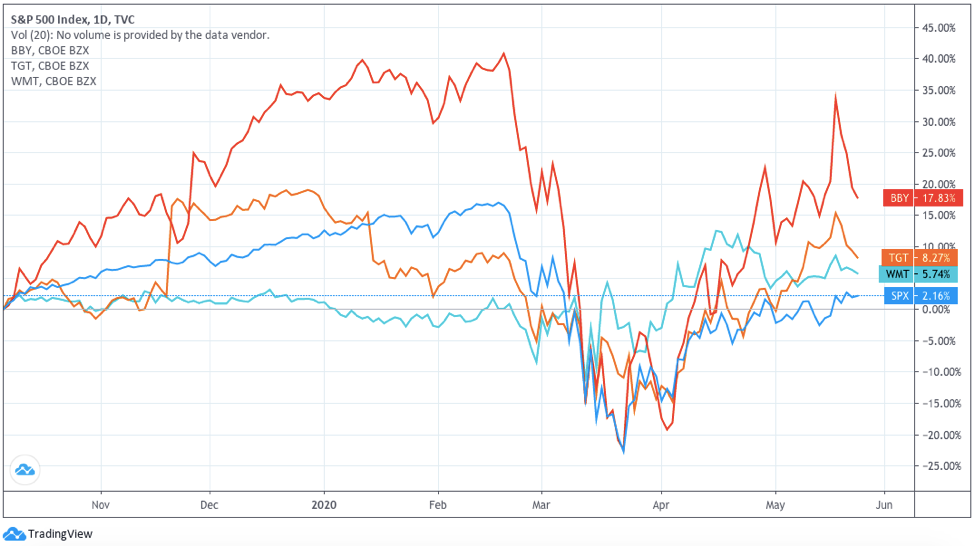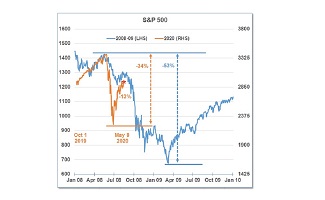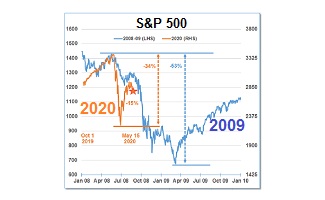This month, some of the best-know retail brands filed for Chapter 11 bankruptcy, including Hertz Global Holdings Inc. (NYSE: HTZ) and J.Crew Group, due to the lockdowns severely deteriorating revenues.
Although the lockdowns forced several retail companies to close physical stores and focus on building online sales, the industry has already been on a transition away from brick-and-mortar operations for the past decade.
According to Coresight Research, in 2018, the retail industry experienced 6,000 brick-and-mortar store closures, which increased to 9,300 in 2019.
Retailers who have already taken steps towards adapting to online operations are faring a lot better during the lockdowns. See below highlights on retail companies Best Buy Co. Inc. (NYSE: BBY), Target Corp. (NYSE: TGT), and Walmart Inc. (NYSE: WMT).
Best Buy
 In Q1/2020, Best Buy initially experienced a spike in sales due to an increase in sales of at-home appliances and technology products. However, as it started closing its storefronts due to the lockdowns, revenue deteriorated.
In Q1/2020, Best Buy initially experienced a spike in sales due to an increase in sales of at-home appliances and technology products. However, as it started closing its storefronts due to the lockdowns, revenue deteriorated.
The pandemic caused several detriments to Best Buy’s operations as it was forced to close all its physical stores, resulting in the furloughing of 51,000 employees as well as other cost-cutting measures.
Although same-store sales dropped 5.3% year-over-year, Best Buy’s past investments in multi-channel sales platforms supported a 154% increase in online sales year-over-year, resulting in the retention of 81% of last year’s reported sales.
To reduce risks and strengthen its balance sheet, Best Buy drew the full amount of US$1.3 billion from its revolving credit facility and suspended all share buyback programs.
This month, Best Buy started allowing customers into physical stores by appointment only, with strict social distancing practices, in addition to the use of personal protective equipment.
Best Buy Q1/2020 Financial Highlights
- Revenue of US$8.6 billion, a 6.3% decrease year-over-year.
- Net income of US$265 million, a 40% decrease year-over-year.
- Balance Sheet consists of Cash and cash equivalents of US$3.9 billion, Current liabilities of US$8.8 billion, and Long-term liabilities of US$3.4 billion.
Target
 Contrary to its competitors, Target decided to keep its physical stores open during Q1/2020, but it saw a high volume of its customer base transition to its online platform.
Contrary to its competitors, Target decided to keep its physical stores open during Q1/2020, but it saw a high volume of its customer base transition to its online platform.
In Q1/2020, Target maintained growing revenues due to its e-commerce platform, with digital sales surging 141% while same-store sales only grew by 10.8%. In April, Target experienced a 282% increase in digital sales.
Target reported 5 million new shoppers using its online store, 2 million new customers using its drive-up service, and over 70 million new sign-ups for its mobile application, Target Circle.
To mitigate increased costs related to growing online sales and deliveries, Target used its retail stores as fulfillment centers, with 80% of digital sales in Q1/2020 delivered through these stores.
However, Target saw its bottom line significantly decrease due to sales flowing towards lower-margin items such as Food and Beverage, and away from higher-margin items such as Apparel and Accessories.
Target was also hit with US$500 million of expenses from increased wages, improved sanitary standards, and other pandemic-related costs. To support front-line service workers, Target raised the hourly pay for its employees by US$2/hour, effective until July 4th.
Target Q1/2020 Financial Highlights
- Revenue of US$19.6 billion, an 11% increase year-over-year.
- Net income of US$284 million, a 64% decrease year-over-year.
- Balance sheet consists of Cash and cash equivalents of US$4.6 billion, Current liabilities of US$14.4 billion, and Long-term liabilities of US$19.2 billion.
Walmart
 Walmart’s recent investments in its online platform paid off as its e-commerce sales grew by 74% in Q1/2020, while same-store sales increased by 10%. Shoppers took fewer trips but average basket sizes increased significantly, with higher volumes of sales for staple items such as toilet paper.
Walmart’s recent investments in its online platform paid off as its e-commerce sales grew by 74% in Q1/2020, while same-store sales increased by 10%. Shoppers took fewer trips but average basket sizes increased significantly, with higher volumes of sales for staple items such as toilet paper.
As the pandemic extends into the indefinite future, consumers have slowly started to return to normal purchasing habits. Walmart experienced three distinct changes in demand for its products, starting from household staples, then to games and office equipment, and then to discretionary items.
In light of the COVID-19 virus, Walmart has spent nearly US$900 million for increasing wages, expanding benefits, and scaling operations, with over 235,000 new hires to support increased sanitary practices and fulfillment of online deliveries.
To support the economy through the pandemic, Walmart has provided a US$35 million provision towards philanthropic support, launched 139 COVID-19 testing sites in store parking lots, and donated US$1 million to support small businesses through its Sam’s Club subsidiary.
Walmart Q1/2020 Financial Highlights
- Revenue of US$135 billion, an 8.6% increase year-over-year.
- Net income of US$3.9 billion, a 3.9% increase year-over-year.
- Balance Sheet consists of Cash and cash equivalents of US$14.9 billion, Current liabilities of US$83 billion, and Long-term liabilities of US$76 billion.
CHART 1: S&P 500 vs BBY, TFT, and WMT





